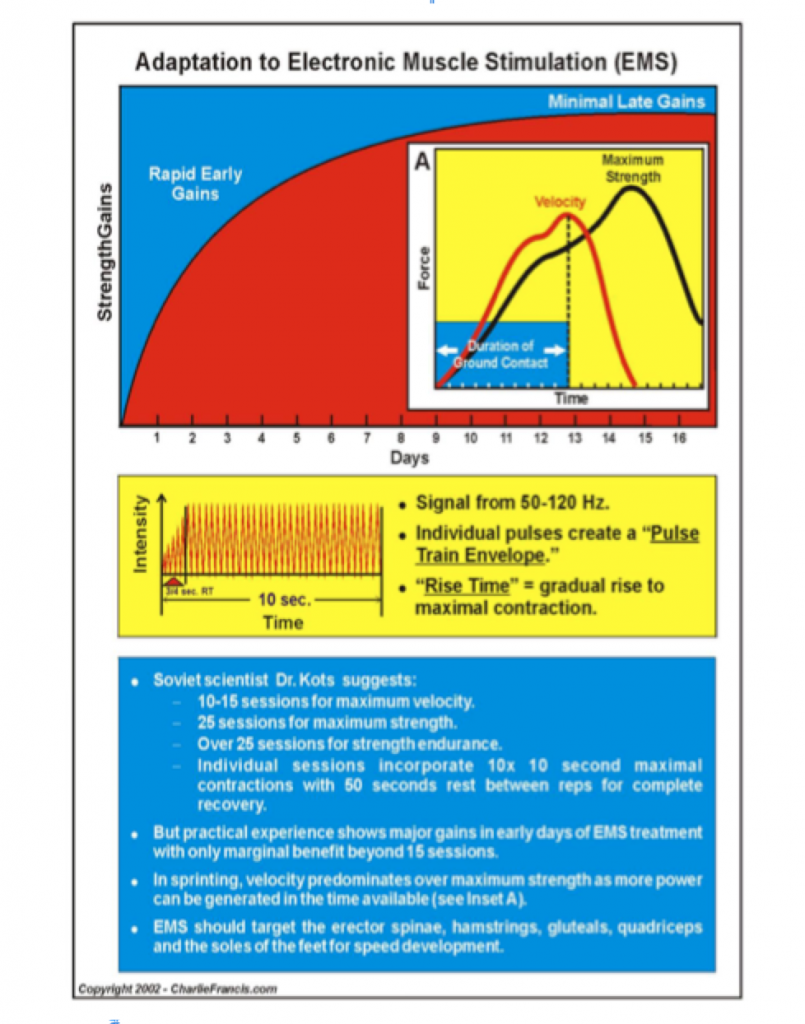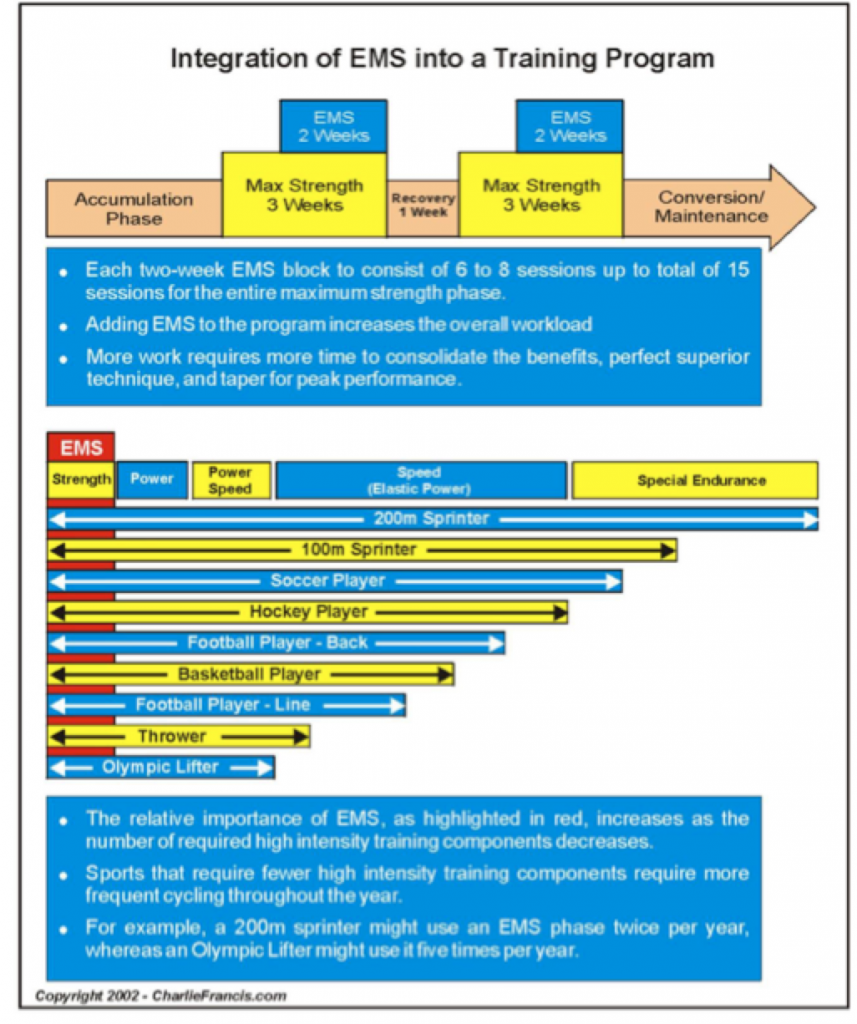ELECTRIC MUSCLE STIMULATION {EMS} FOR MAXIMUM SPEED ENHANCEMENT. Part one

By Charlie Francis (www.charliefrancis.com)
ADAPTATION TO EMS

Background and History of EMS in Training
If EMS is effective then when and where should it be applied? What exactly is its effect on the muscular and central nervous systems? And what improvements should be expected, over what periods of time? All of these questions will be answered in considering the body’s adaptation to EMS.
“EMS” is electronic muscle stimulation, operated indeed for many functions among many different types and classes of users. In these diagrams, we will focus only on its potential for maximum strength enhancement, and not its value as a means of recovery, as a rehabilitation tool, or as motor learning and muscle recruitment technology – all of which, by can indeed utilize EMS extensively. EMS had been used in Eastern Europe in the Communist Bloc countries from 1950 onwards, but made its arrival in the West in 1973 only when Dr. Y. Kots of the Central Institute for Physical Culture in the USSR presented a paper on its use at Concordia University in Montreal.
He outlined what he perceived to be a remarkable potential for strength enhancement well beyond that which was possible by traditional – voluntary, at the muscular level – means. Naturally, much as EMS infomercials exact suspicion and distrust, many were skeptical of Dr. Kots’ studies, and claimed that EMS was not nearly as effective as Kots had demonstrated.
Experiments attempting to prove the ineffectiveness of EMS used a crude comparison of voluntary contracted muscles and those contracted using an EMS stimulus. The fallacy is that the two contractions are essentially incomparable.
Voluntary muscular contractions roll through the muscle in a wave to generate a coordinated, directed force, while an EMS stimulus fires all motor neurons in the treated area simultaneously, creating an uncoordinated contraction. The EMS contraction is primarily isometric in nature, against resistance without significant shortening of muscle fibres, and with marked increase in muscle tone.
Kots showed, using a tensiometric device, that the muscle tension produced in a maximal EMS contraction can be up to 30% higher than over a maximal voluntary contraction. The reason for this is that since individual muscle fibres can become exhausted in just seconds, the body has several safeguards to maintain the utility of muscle fibre and prolong endurance. There is never a period of time, even in the most intense activity, that every muscle fibre is fired.
EMS Impact on Muscle Fibre and Recruitment Velocity
Slow-twitch red fibre is used first in voluntary contractions, as it represents the most energy efficient means of contraction. Fast- twitch white fibre is only added when the load requires it; white fibre is the “power” fibre. Muscles fire their individual fibres in relays, so that some fibres are kept as a reserve for when those in use are exhausted. These reserve fibres will be predominately white under voluntary contraction. All of these safeguards are instituted biomechanically with the aim to prevent overstress on the central nervous system.
EMS bypasses the CNS, and works directly on the muscles it is applied to, with no crossover effect. Thus there is no limit to the amount of fibre that can be activated, as the EMS stimulus “spills over” to the white fibre, a training stimulus unattainable by any other means. Given sufficient current, this exercise is supra-maximal; in other words, above the natural maximum. Thus it enhances muscle density by favouring improved muscle recruitment over cross-sectional growth (bulk). In addition, EMS training optimizes fibre splitting and the conversion of intermediate fibre to fast-twitch white fibre.
Recruitment velocity refers to the rate at which a given muscle fibre can achieve maximum tension,and corresponds to the power force output. There are of course various classes of fibre, including some intermediate fibres, but in general white fibre has a recruitment velocity of approximately twenty milliseconds, and red fibre has a recruitment velocity of sixty-five milliseconds. Red muscle fibre has preference in voluntary contractions as white fibre is only added when it is determined that additional force is required.
In EMS, the opposite phenomenon is observed. The nonspecific current of EMS stimulus reverses the natural recruitment order, because it flows more easily through the larger neuron of the white fibre – there is less resistance. This forces red and intermediate fibres to speed up their recruitment rates in order to compete with the white fibre, resulting in the conversion to fast-twitch.
For these reasons, EMS is an ideal means for improving recruitment velocity across all fibre types, as well as attaining strength gains, especially in explosive events.
Prioritizing EMS
As mentioned earlier, EMS plateaus the most quickly of all training components. At the top of the diagram, the period of diminishing returns is once again expressed. As you can see, most of the gains are achieved after ten sessions, with smaller gains over the next five sessions, and negligible benefits thereafter. The period ten to fifteen sessions is also an ideal period to maximize recruitment velocity, and thus it is logical to perform ten to fifteen sessions at most over a training period.
The curves of recruitment velocity and maximum strength are charted with reference to the number of weeks that it would take to achieve each maximum. Maximum strength, naturally, peaks at the end of the window for effective gains from EMS. Recruitment velocity, however, peaks at an earlier time. This is a very important graph when it comes to EMS. Generally speaking, a sprinter would place an emphasis on maximum recruitment velocity rather than maximum strength. Simply put, it is increased recruitment velocity that will lead to the explosive power that a sprinter desires at the start of his race.
The top sprinter experiences a much smaller time of ground contact than the beginner, because he is stronger and more explosive and is simply moving faster off the ground. Since the force-time of the top sprinter would be so steep, ground contact may have ceased by the time that maximum strength would be necessary and of relevance. This is illustrated on the graph. Thus the extra strength is likely to be extraneous.
To be explosive, a sprinter does not need to be a champion weightlifter. Besides, much of that extra maximum strength work will have most its value when competition arrives. In addition, more sessions of EMS translate into a longer tapering period and reduced opportunities for other high intensity work.
Most relevantly, though, as maximum strength continues to increase after the twelfth or thirteenth session, until about twenty-five sessions, recruitment velocity in fact begins to decrease. And since it is recruitment velocity, and not strength, that is the ultimate goal, it seems logical to stop before the point of maximum strength. Strength gains at that point would be relatively small and unlikely to make a significant difference in a race situation regardless.
There are two reasons for which attaining maximum strength by performing more EMS sessions would make logical sense for a sprinter. First, beginners will have longer ground contact and thus will need to utilize fibres over a longer duration along the strength continuum.
Second, the curve of maximum strength may be shifted. An athlete who lacks strength and muscle bulk as well as density may need to acquire a certain level of strength for fibre conversion. In this case, reaching the peak of the maximum strength curve might have positive consequences later in training.
In a more advanced situation, the curve might be shifted, as if on a string, so that the peak of maximum strength would rest above – directly above or nearly – the curve of recruitment velocity. Of course, all of this applies mostly to the sprinter. The Olympic lifter clearly places less of a priority on recruitment velocity and more on maximum strength. He might perform EMS closer to the peak of maximum strength.
This is tied in part to the concept of EMS conversion. While it is recommended that no conversion weights be performed, and no other conversion exercises, EMS is used in conversion to some degree.
As far as movement and velocity goes, EMS rests at the bottom; there is no movement and no velocity. And since the strength gains are lost so quickly after plateau with EMS, it makes sense to utilize the gains from EMS in explosive power and speed work, as well as in the development of recruitment velocity and fast-twitch fibre.
Individual sessions on a three high intensity day per scheme would be performed the night after each of the high intensity days. In theory, EMS could be performed every day, even three times a day with four hour breaks, because it has no CNS demand and can be recovered from muscularly in that time. But it acts as a natural complement to high intensity speed work and ensures that there is not too much high intensity work on the low days.
In addition, in case some bruising or muscle damage occurs, or recovery takes longer than expected, there is maximum interval before the next high intensity speed training session. It should be separated from work by at least two hours, and preferably four. If it is done before bed – even in bed – the supra-maximal stimulus it provides promotes the release of growth hormone during sleep.
The EMS Session
In preparation, a hot shower will provide adequate initial stimulation, heating the muscle motor neurons, lowering electrical resistance, and making them more receptive to EMS. Contrast showers are an alternative, and of course have the added benefit of promoting CNS recovery. However before EMS the final shower should be hot. The EMS session should begin in a gentle pulsing mode for three to five minutes; this would be the same mode as used by massage therapists for muscular recovery. The same pulsing session should follow the intensive EMS.
The length of a given contraction varies among athletes and muscle types. Normally, a sprinter would use a guideline the maximum contraction time of ten seconds, with ten repetitions at this duration. There must be a fifty second rest between contractions; otherwise, the athlete will be unable to maintain maximum contraction on the next repetition. In fact, a rest period that is too short may change the nature of the exercise so that it enhances red muscle fibre rather than white.
Shot-putters and other athletes that require less of a speed and speed endurance component in their training often find that they can maintain a maximal contraction over about six seconds. In any case, the full rest period must be observed.
The most common misuse of EMS is that athletes never come near the level of contraction that they need for optimal results. A target EMS intensity would be 30% more than the maximum possible voluntary contraction. The contraction is very large, and feels that way. With proper current, some athlete may need to bite down on a piece of leather (or whatever is available). The feeling is similar to riding on a bike up a long and steep hill; an intense burn. This is normal and should not be avoided or shied away from.
Of course, the next issue is where EMS should be applied. As a general rule, no more than two muscle groups should be stimulated simultaneously, as the athlete must be able to determine the origin of the stimulus. Maximum strength EMS is applied to the quadriceps, hamstrings, gluteals, and erector spinae primarily in a sprinter. At maximum speed, it is these muscles that play the greatest role in power development around the hip joint, where the power output is seven times that of any other joint.
The abdominals play a role also, but as they have rotational movement and focus on primary support, they are more of a factor in speed endurance and longer distances. When cases of insufficient foot strength arise, the soles of the feet may be treated with EMS as the pods are applied with the athlete in a standing position.

The Relevance of EMS
Late-night television infomercials swear that EMS is the shortcut to tremendous- even unnatural- maximum strength gains. Many athletes use it and see limited results, especially for the price… literally and muscularly. And most Olympic sprinters use EMS presumably effectively – to build strength and power. EMS has been one of the most hotly-contested topics on the athletic circuit.
Its claimed benefits, to maximum strength, could potentially make it a useful and vital tool for athletes as diverse as the Olympic lifter and the basketball player.
But is it just a cleverly-disguised technological gimmick not worth the time and expense of money or energy? Or is it the best strength machine ever made, strength training for the lazy everyman and the top athlete alike? As in almost all situations, the answer lies in that grey area between the two extremes. Joe the Couch Potato is not going to end up with muscles that look like Schwarzenegger, but EMS can be an extremely effective tool for any athlete and is well worth the investment for many events.
In order to determine the relevance for a given event or sport, examine the graph on the low half of the diagram. The red portion – strength – is what is gained by training with EMS.
Of course, these strength gains would not be achieved entirely by EMS; even when EMS use in a training career is at its peak, other maximum strength weights would be performed, along with accumulation weights, and even conversion weights in some cases. But in some cases EMS can account for well over the majority of potential strength gains.
In any event, it is clear that strength has a lesser significance in the 200metre race than in the Olympic lift. This is intuitive: a relatively weak lifter has never won a weight-lifting competition, but there have been successful 200metre runners who were not exactly ripped.
But it is also theoretical, and this can help distinguish the relative relevancies of EMS for a 100metre sprinter and a basketball player. Earlier, it was explained how strength is of principal value over the first ten metres of a race, as the sprinter require enormous force to power himself out of the blocks and create the necessary acceleration. It is somewhat important over the next ten metres, and less important between twenty and thirty metres. At this point, as the athlete adopts a more upright position, strength ceases to be a major factor in terms of speed generation and maintenance. And the sprinter still does have seventy metres to run.
Clearly, strength does play a major role in deciding races among top sprinters; Ben Johnson always had an advantage because he was the strongest starter and the fastest over the first ten meters. But strength alone will not decide a race. The relative importance of strength training for a 100-meter sprinter would be between ten and fifteen percent. A basketball player, conversely, requires large amounts of strength under the hoop, using tremendous force to propel himself into the air for a block or a rebound. He does use speed running down the floor, but certainly not at maximum for long distances. Strength, then, is of greater relative importance for a basketball player, in the order of twenty to twenty-five percent.
The Olympic lifter performs all of his lifts in the strength, power, and power speed stages. Thus strength is of extreme significance, and EMS of extreme relevance to training. The relative importance of EMS increases, in conjunction with the body’s ability to tolerate it, with fewer and fewer additional high intensity components that need to be executed.
To be continued

